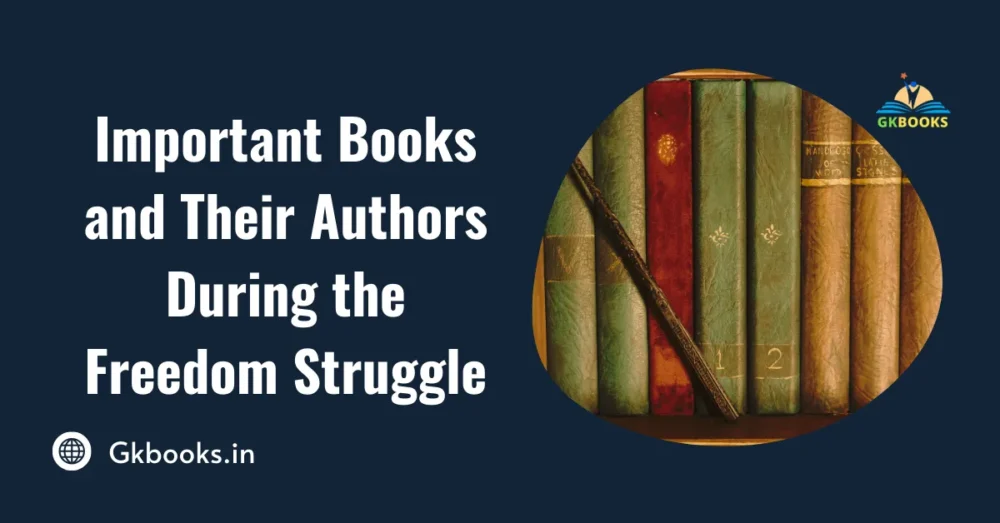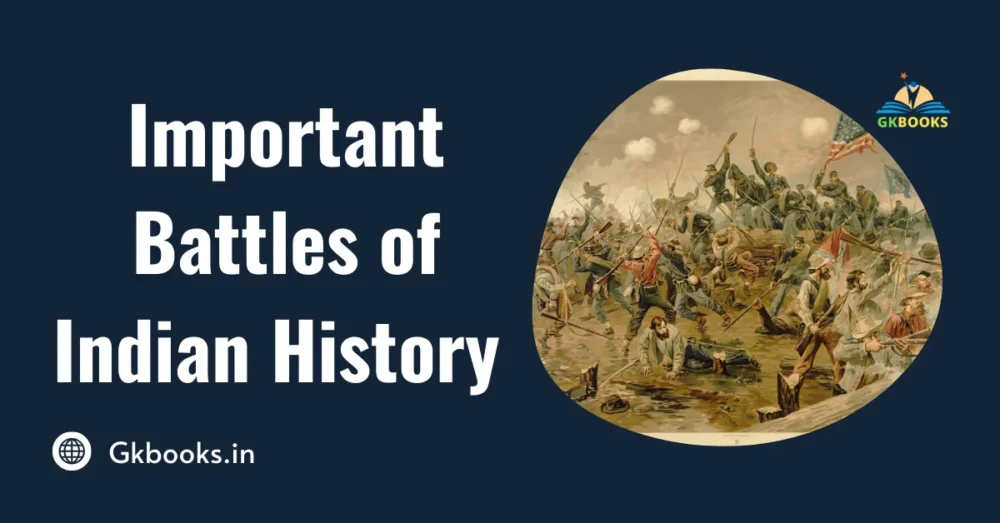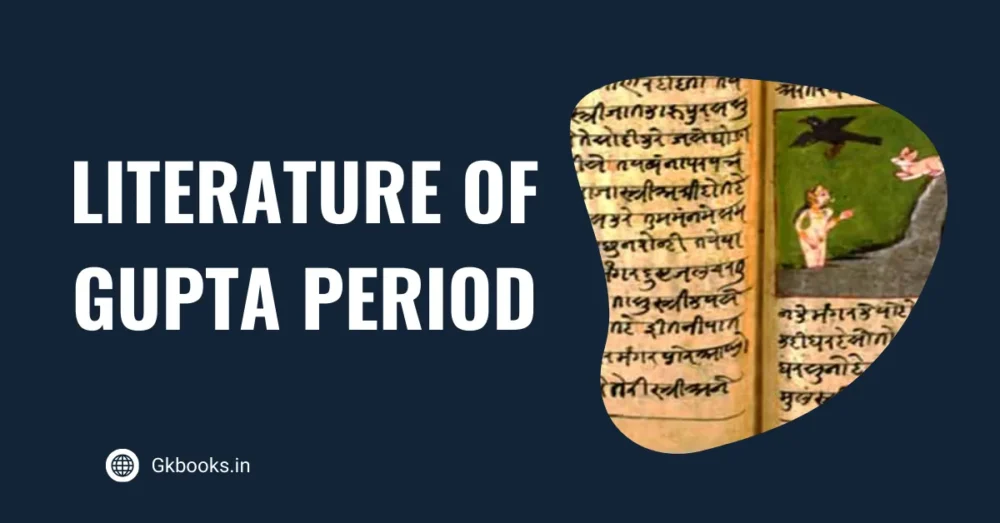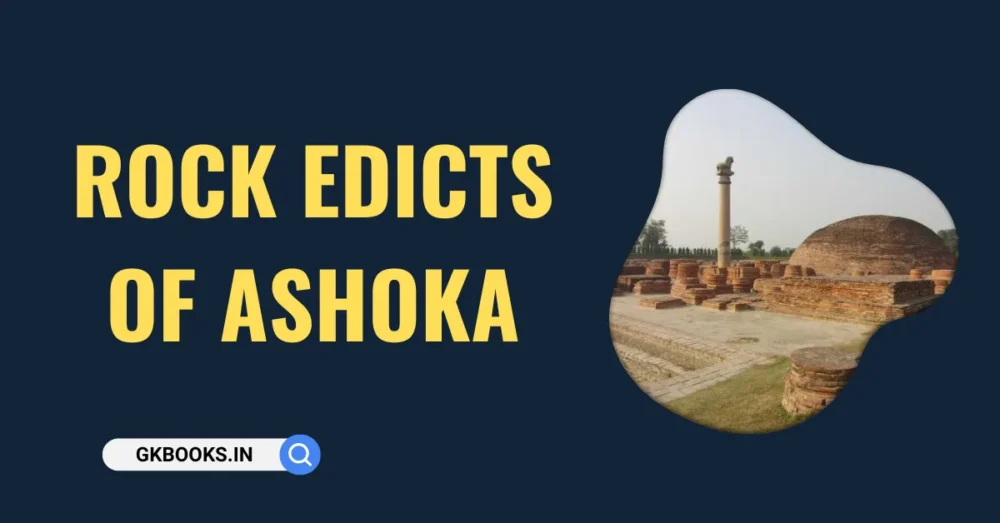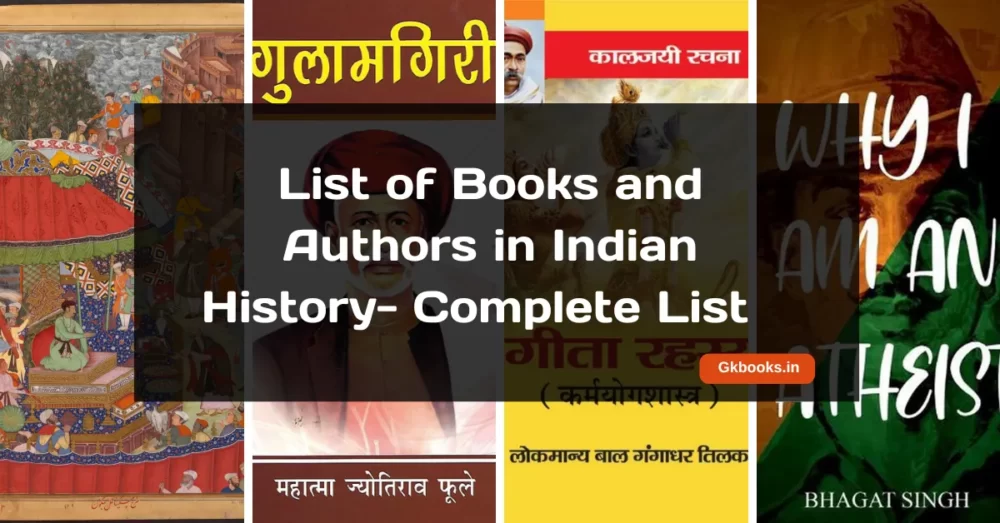Bindusara was the second emperor of the Mauryan dynasty in Ancient India, following the footsteps of his father, Chandragupta Maurya, who founded the empire. He ruled Magadha and played a key role in consolidating the vast empire established by his father.
Reign: c. 297 BCE – c. 273 BCE
Dynasty: Maurya
Title: Amitraghāta (“slayer of enemies”)
◾ Explore all Indian History Notes
Historical Names
- Greco-Roman Writers: Referred to Bindusara as Amitrochates, derived from the Sanskrit title Amitraghāta which means “slayer of enemies.”
Family
- Father: Chandragupta Maurya, the founder of the Mauryan Empire.
- Son: Ashoka, one of India’s most famous and influential emperors, is known for his role in spreading Buddhism.
Legacy and Reign
- Administration: Bindusara is credited with strengthening the empire his father built, ensuring the stability and expansion of Mauryan influence.
- Southern Conquests: According to the 16th-century Tibetan Buddhist writer, Taranatha, Bindusara extended his rule over parts of Southern India. However, many modern historians question the historical accuracy of these claims.
Sources and Historical Accounts
- Documentation: Unlike Chandragupta and Ashoka, Bindusara’s life is not well-documented. Much of his information comes from legends and texts written centuries after his death, making historical details about his reign less reliable.
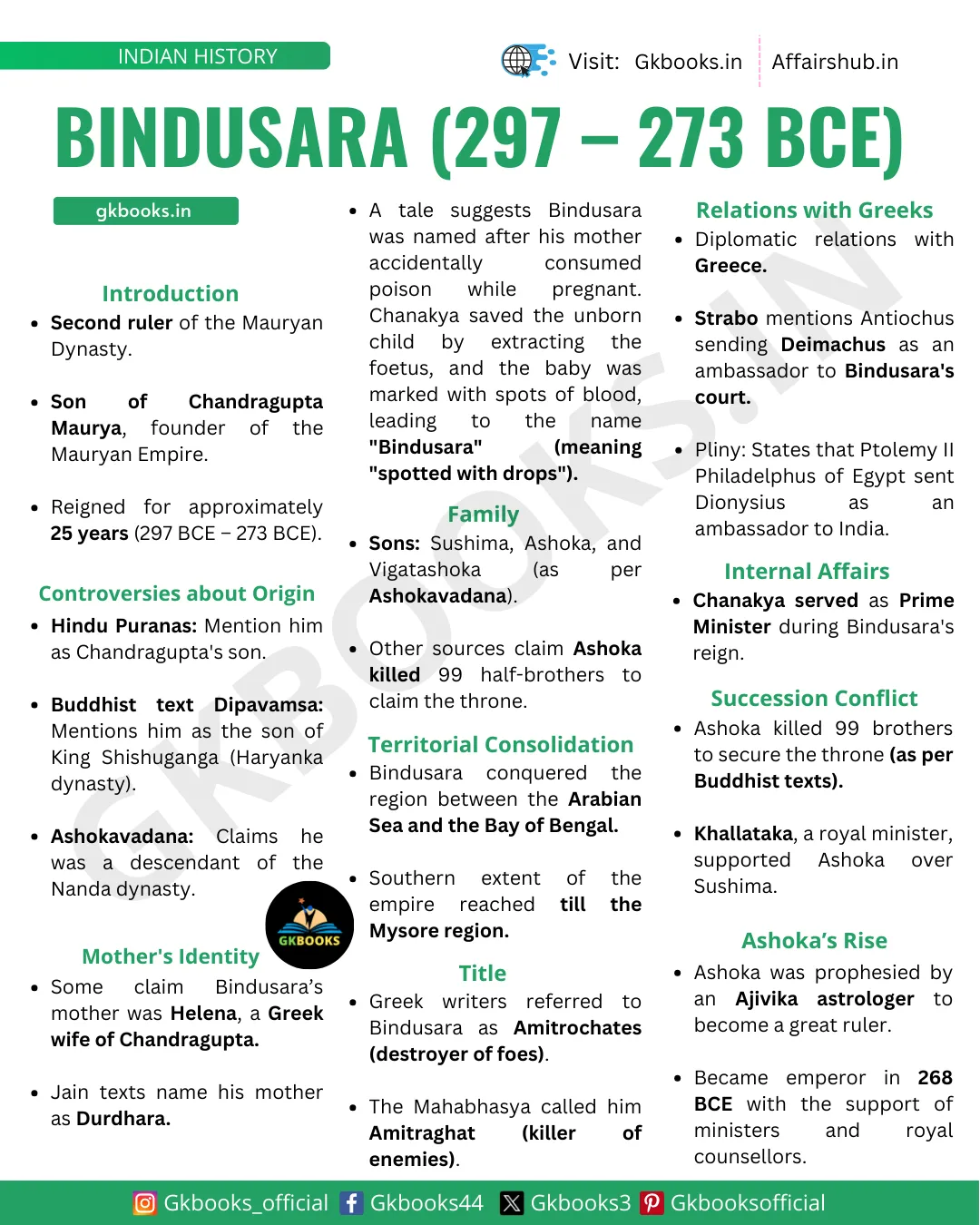
Documentation of Bindusara’s Life: Ancient and Medieval Sources
The life of Bindusara, the second Mauryan emperor, is not well-documented in ancient and medieval sources.
Most available information comes from later legends and texts focused on either his father, Chandragupta, or his son, Ashoka.
These sources, while useful for making inferences, are often considered unreliable due to their historical distance and the influence of religious contexts.
Key Sources of Information on Bindusara
Jain Legends
- Hemachandra’s Parishishta-Parvan: Written more than a thousand years after Bindusara’s death, this 12th-century Jain text focuses mainly on Chandragupta and provides only indirect information about Bindusara.
Buddhist Legends
- Divyavadana: Contains multiple stories, including Ashokavadana and Pamsupradanavadana, which offer some details about Bindusara.
- Dipavamsa and Mahavamsa: Sri Lankan chronicles that provide genealogical information on the Mauryan dynasty, including Bindusara.
- Vamsatthappakasini (Mahavamsa Tika): A commentary on the Mahavamsa, offering additional details.
- Samantapasadika: Another Buddhist source with limited details about Bindusara.
- Taranatha’s Writings: A 16th-century Tibetan Buddhist author, Taranatha, provides information on Bindusara’s reign, although some of it is viewed skeptically by historians.
Hindu Puranas
- The Puranas include genealogies of the Mauryan rulers, mentioning Bindusara in the context of the dynasty’s succession.
Greek Sources
- Amitrochates: Bindusara is mentioned by this name, or variations of it, in Greek texts, offering an external perspective on his rule.
Early Life of Bindusara
Parents and Ancestry
Father
- Bindusara was born to Chandragupta Maurya, the founder of the Mauryan Empire, as attested by several ancient sources, such as the Puranas and Mahavamsa.
Alternative Accounts:
- The Dipavamsa presents a different lineage, claiming that Bindusara was the son of Shushunaga, not Chandragupta.
- The prose version of the Ashokavadana even asserts that Bindusara was the son of Nanda and a 10th-generation descendant of Bimbisara, omitting Chandragupta entirely.
- The metrical version of Ashokavadana contains a similar genealogy, though with some variations.
Mother
- Chandragupta’s marriage alliance with the Seleucid Empire led to speculation that Bindusara’s mother might have been of Greek or Macedonian descent, though there is no concrete evidence supporting this theory.
- According to the 12th-century Jain writer Hemachandra in his Parishishta-Parvan, Bindusara’s mother was named Durdhara.
Names and Titles of Bindusara
Bindusara: The name “Bindusara” appears in various ancient texts, including:
- Buddhist texts: Dipavamsa and Mahavamsa refer to him as “Bindusaro.”
- Jain texts: Parishishta-Parvan mentions him as “Bindusara.”
- Hindu texts: Vishnu Purana calls him “Vindusara.”
Alternative Names in Puranas: Some Puranas mention alternative names for Chandragupta’s successor, likely due to clerical errors:
- Bhagavata Purana: “Varisara” or “Varikara.”
- Vayu Purana: “Bhadrasara” or “Nandasara.”
Amitra-ghāta
- The Mahabhashya refers to Bindusara as Amitra-ghāta (Sanskrit for “slayer of enemies”).
- Greek writers such as Strabo and Athenaeus referred to him as Allitrochades and Amitrochates, derived from the Sanskrit title.
Devanampriya: Bindusara was also given the title Devanampriya, meaning “The Beloved of the Gods,” a title shared with his son Ashoka.
Simhasena: According to the Jain text Rajavali-Katha, Bindusara’s birth name was Simhasena.
The Legend Behind the Name “Bindusara”
Both Buddhist and Jain texts offer a similar legend regarding the origin of the name “Bindusara.”
Buddhist Version (Mahavamsa and Mahavamsa Tikka)
- Chandragupta’s minister Chanakya secretly added poison to the emperor’s food to build his immunity against potential poisoning attempts. One day, Chandragupta unknowingly shared the poisoned food with his pregnant wife.
- Chanakya, realizing the danger, acted quickly. The empress was seven days away from giving birth. Chanakya beheaded her, performed a cesarean, and removed the fetus. He placed the fetus in the belly of a freshly killed goat each day for seven days, after which the child was “born” and named Bindusara because his body was marked with spots of goat’s blood (from the Sanskrit “bindu” meaning drop).
Jain Version (Parishishta-Parvan)
- Minister Chanakya saved the unborn child by cutting open the dead empress’s womb after a drop of poison had already touched the baby’s head. The child was named Bindusara, meaning “the strength of the drop,” referring to the single drop of poison that touched him.
Family of Bindusara
Sons of Bindusara
Sushima
- The eldest son of Bindusara, often referred to as Sumana or Sushima, is noted in various texts as his potential successor.
Ashoka
- One of Bindusara’s most famous sons, Ashoka, later became the emperor and is widely known for his role in spreading Buddhism.
- His mother was Subhadrangi, the daughter of a Brahmin from the city of Champa. According to legend, an astrologer named Pingalwatsa predicted that one of her sons would become an emperor, while the other would lead a religious life.
- Ashoka was disliked by Bindusara due to his “hard limbs.”
Vigatashoka
- Another son of Bindusara and Subhadrangi, Vigatashoka, is also mentioned alongside Ashoka.
Tishya (Tissa)
- The youngest son, Tishya (or Tissa), is stated to have shared the same mother as Ashoka, according to the Mahavamsa.
Wives and Other Children
- According to the Mahavamsa, Bindusara had 101 sons from 16 wives.
- Subhadrangi, Ashoka’s mother, was initially trained as the imperial barber by Bindusara’s jealous wives, but after impressing the emperor, she was made the chief empress due to her Brahmin lineage.
- The Divyavadana and Vamsatthappakasini offer alternative names for Ashoka’s mother, including Janapadakalyani and Dhamma respectively.
Bindusara’s Reign
Taranatha’s Account
- Claim: Taranatha, a 16th-century Tibetan Buddhist author, states that Chanakya destroyed the nobles and kings of 16 towns, making Bindusara the master of all territory between the Arabian Sea and the Bay of Bengal.
- Interpretations:
- Conquest Perspective: Some historians view this as evidence of Bindusara’s conquest of the Deccan.
- Suppression Perspective: Others argue it merely reflects the suppression of revolts.
Sailendra Nath Sen’s Analysis
- Claim: Sen notes that the Mauryan Empire extended from the western sea (near Saurashtra) to the eastern sea (near Bengal) during Chandragupta’s reign.
- Evidence:
- Ashoka’s Inscriptions: Found in southern India, these do not mention any conquest of the Deccan by Bindusara.
- Conclusion: Sen believes Bindusara did not expand the empire but retained the territories inherited from Chandragupta.
K. Krishna Reddy’s Argument
- Claim: Reddy argues that Ashoka’s inscriptions would have boasted about southern Indian conquests had they occurred during Bindusara’s reign.
- Conclusion:
- He posits that the Mauryan Empire reached Mysore under Bindusara but that the southernmost kingdoms acknowledged Mauryan suzerainty without being fully conquered.
Alain Daniélou’s Perspective
- Claim: Daniélou suggests that Bindusara inherited an empire that included the Deccan region but made no significant territorial additions.
- Nominal Control:
- He believes Bindusara brought the Cheras, Cholas, and Satyaputras under nominal Mauryan control, although he could not defeat their armies.
- Support: Daniélou cites references in ancient Tamil literature to Vamba Moriyar (Mauryan conquest) but notes the lack of details about expeditions.
- Conclusion: Bindusara’s key achievement was the organization and consolidation of the empire inherited from Chandragupta.
Takshashila Revolt and Bindusara’s Administration
Takshashila Revolt
- Background: The Mahavamsa suggests that Bindusara appointed his son Ashoka as the Viceroy of Ujjayini.
- Siege of Takshashila: According to the Ashokavadana, Bindusara sent Ashoka to lay siege to Takshashila.
- Emperor’s Refusal: Bindusara refused to provide weapons or chariots for Ashoka’s expedition.
- Divine Intervention: Deities (devatas) miraculously supplied Ashoka with soldiers and weapons.
- Residents’ Response: Upon reaching Takshashila, the residents stated that their opposition was towards Bindusara’s oppressive ministers, not the Emperor or Ashoka.
- Result: Ashoka entered the city without opposition, with the devatas prophesying his future rule over the entire earth.
- Second Revolt: Shortly before Bindusara’s death, a second revolt occurred in Takshashila.
- Failure of Sushima: Bindusara sent his other son, Sushima, to quell this rebellion, but he was unsuccessful.
Advisors and Administration
Chanakya’s Role
- According to the Rajavali-Katha, Chanakya, the chief advisor of Chandragupta, accompanied him into retirement after handing administration over to Bindusara.
- However, the Parishishta-Parvan states that Chanakya remained Bindusara’s prime minister.
Legend of Chanakya’s Death
- Chanakya advised Bindusara to appoint a man named Subandhu as a minister.
- Subandhu’s Jealousy: Subandhu grew jealous and falsely accused Chanakya of wrongdoing against his mother.
- Bindusara’s Reaction: After confirming Subandhu’s claims, Bindusara began to hate Chanakya.
- Retirement and Death: Chanakya, an old man at this time, chose to retire and starve himself to death.
- Reconciliation Attempt: Bindusara later learned the truth and pleaded with Chanakya to return, but Chanakya refused.
- Subandhu’s Treachery: Subandhu attempted to appease Chanakya but ultimately burned him to death.
- Consequences: Due to Chanakya’s curse, Subandhu later retired and became a monk.
Imperial Councillors:
- The Ashokavadana indicates that Bindusara had 500 imperial councillors.
- Notable officials included Khallataka and Radhagupta, who played significant roles in helping Ashoka ascend to the throne after Bindusara’s death.
Foreign Relations of Bindusara
Diplomatic Relations with the Greeks
- Friendly Diplomatic Ties: Bindusara maintained friendly relations with the Greeks, reflecting a significant aspect of his foreign policy.
Ambassador
- Deimachos of Plateia served as the ambassador from Seleucid King Antiochus I at Bindusara’s court.
- Treatise: Deimachos authored a treatise titled “On Piety” (Peri Eusebeias).
Interaction with Antiochus I
- Request for Goods: Bindusara requested sweet wine, dried figs, and a sophist from Antiochus.
- Response: Antiochus agreed to send the wine and figs but stated that Greek laws prohibited him from selling a sophist.
- Significance of the Request: This request suggests Bindusara’s interest in Greek philosophy and education, highlighting his desire for intellectual engagement with Greek culture.
Welcoming Greek Visitors
- Iambulus: According to Diodorus, a Greek author named Iambulus was welcomed at the court of the king of Palibothra (modern-day Pataliputra), usually identified as Bindusara.
Envoys from Other Kingdoms
- Ptolemaic Relations: Pliny the Elder mentions that the Ptolemaic king Philadelphus sent an envoy named Dionysius to India.
- Timing: Historian Sailendra Nath Sen suggests that this event likely took place during Bindusara’s reign.
Bindusara’s Religious Affiliations
Brahmanism
- Brahmana Votary: Buddhist texts like Samantapasadika and Mahavamsa suggest that Bindusara followed Brahmanism, referring to him as a “Brahmana bhatto” (votary of the Brahmanas).
- Jain Sources: There is no mention of Bindusara’s faith in Jain texts, indicating a lack of recorded Jain perspectives on his religious beliefs.
Possible Buddhist Connections
- Sanchi Inscription: A fragmentary inscription at Sanchi, possibly referring to Bindusara, hints at his connection with the Buddhist order at Sanchi, dating back to the 3rd century BCE.
Prophecy Regarding Ashoka
- Astrologer/Priest: An Ajivika astrologer or priest at Bindusara’s court prophesied the future greatness of Prince Ashoka.
- Pingalavatsa: This astrologer is named Pingalavatsa in the Pamsupradanavadana (part of the Divyavadana), recognized as an Ajivika parivrajaka (wandering teacher).
Death of Bindusara
Date
- Historical Evidence: Bindusara is believed to have died in the 270s BCE.
- Upinder Singh: Suggests a date around 273 BCE.
- Alain Daniélou: Estimates his death around 274 BCE.
- Sailendra Nath Sen: Proposes a range of 273-272 BCE and notes a four-year succession struggle leading to Ashoka’s rise in 269-268 BCE.
Reign Duration
- Mahavamsa: Claims Bindusara reigned for 28 years.
- Puranas: State a reign of 25 years.
- Manjushri-Mula-Kalpa: Incorrectly asserts that he ruled for 70 years.
Succession to Ashoka
- General Consensus: All sources agree that Ashoka succeeded Bindusara, albeit with differing narratives regarding the succession process.
Accounts of Succession
Mahavamsa Account
- Ashoka was serving as the viceroy of Ujjain when he learned of his father’s illness.
- Upon reaching Pataliputra, Ashoka killed his 99 brothers (except Tishya) to secure his claim to the throne.
Prose Version of Ashokavadana
- Sushima, Bindusara’s favorite son, exhibited unworthiness by throwing his gauntlet at the prime minister, Khallataka.
- Khallataka, believing Sushima unfit for leadership, proposed Ashoka as the successor to the 500 imperial councillors, citing prophecies of Ashoka’s future greatness.
- Before his death, Bindusara expressed a desire for Sushima to be crowned, with Ashoka as the governor of Takshashila.
- Sushima was then dispatched to quell a rebellion in Takshashila.
- As Bindusara lay dying, the ministers suggested Ashoka be made temporary emperor until Sushima’s return. This suggestion angered Bindusara.
- Ashoka declared that if he was destined to succeed, the devatas (deities) would place the crown on his head. Miraculously, this occurred just before Bindusara’s death.
- Sushima, upon hearing of Ashoka’s crowning, attempted to claim the throne but met his end by being tricked into a pit of burning charcoal by Ashoka’s ally, Radhagupta.
Contradictory Sources
- Brahmanda Purana: States that Bindusara himself crowned Ashoka.
- Rajavali-Katha: Suggests that Bindusara retired and handed the throne to Ashoka.
Conclusion
Bindusara’s reign was marked by efforts to solidify and expand the Mauryan Empire initiated by his father. Despite the challenges in historical documentation, he is recognized for his administrative capabilities, family legacy, and significant foreign relations, setting the stage for his son Ashoka’s transformative rule.
I hope you find this article interesting. For more history-related infographics, visit our official Instagram or Facebook page. Keep visiting and keep growing!

